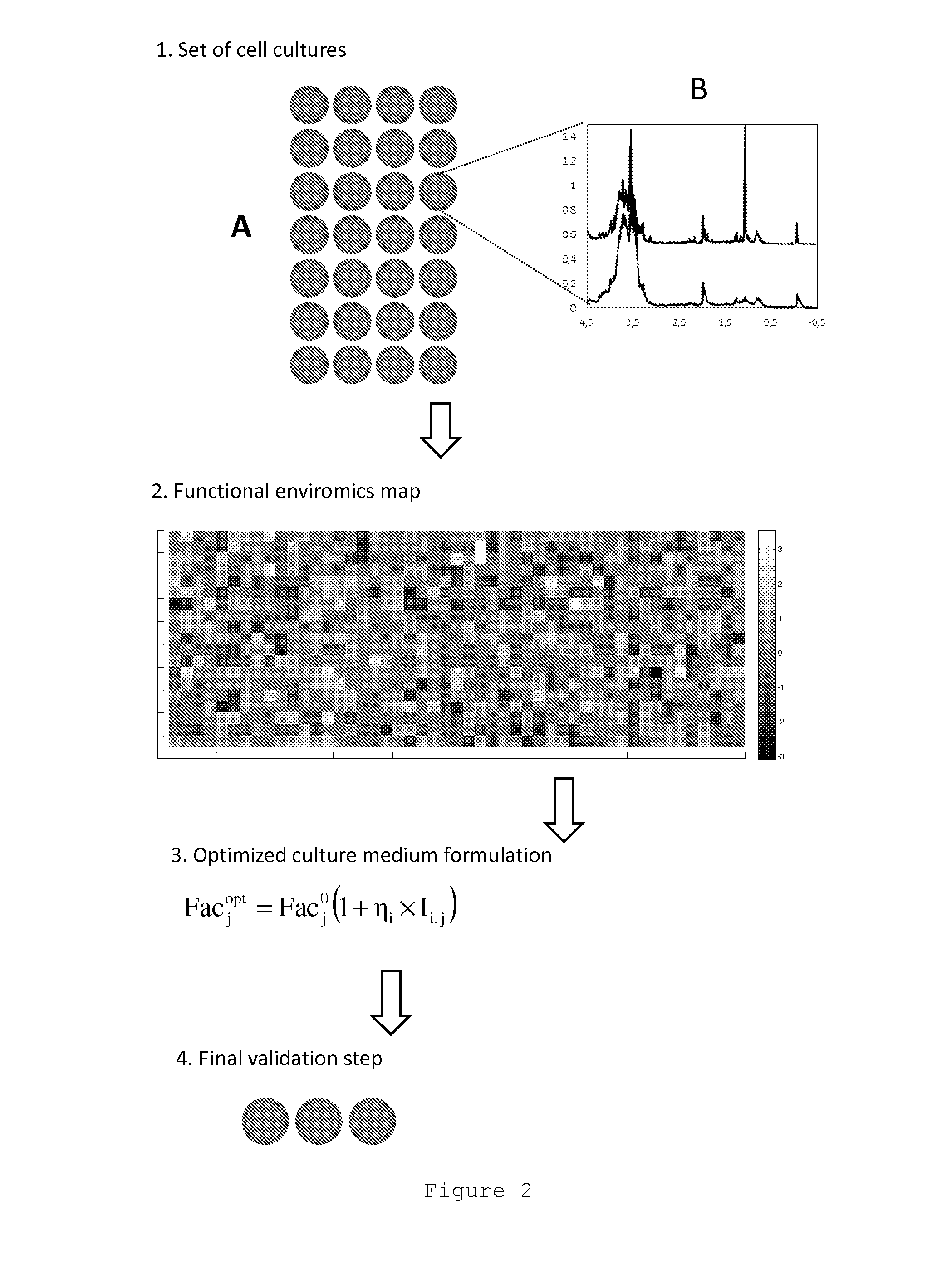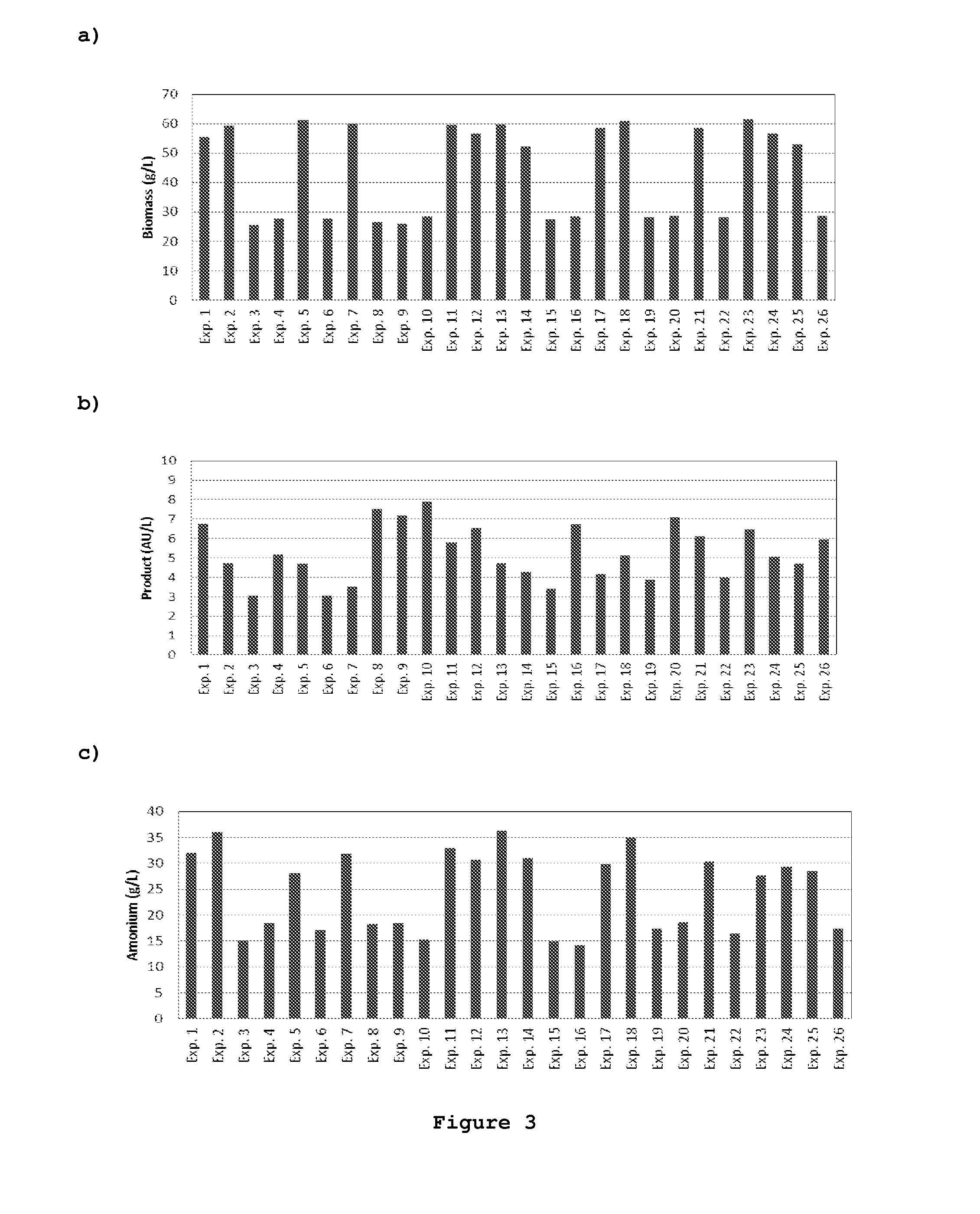Functional enviromics method for cell culture media engineering
a technology of cell culture media and enviroment, applied in the field of functional enviroment method of cell culture media engineering, can solve the problems of significantly limiting the ability to discover complex interactions between many media ingredients, time-consuming and costly methods, and progressively discontinuing the use of sera
- Summary
- Abstract
- Description
- Claims
- Application Information
AI Technical Summary
Benefits of technology
Problems solved by technology
Method used
Image
Examples
example 1
Elementary Cellular Functions for the Yeast Pichia pastoris X33
[0076]Herein the steps for obtaining the working set of elementary cellular functions for the recombinant yeast Pichia pastoris X33 are described.
[0077]First, a metabolic network was built from literature sources, namely the KEGG database [30] and papers by Chung et al. [31] and elik et al. [32]. The genes associated to each reaction are in most cases known and can be found in Chung et al. [31]. The metabolic network was further simplified by lumping together in single reactions the anabolic pathways. The resulting metabolic network has 99 reactions (thus 99 fluxes), 89 intracellular metabolites and 9 extracellular metabolites. The complete set of metabolic reactions are listed in Table 1.
TABLE 1List of metabolic reactions of a recombinant Pichiapastoris X33 strain expressing a protein of empirical formulaCH1.965N0.271O0.535S0.006Uptake reactionsR11 ATP + 1 GlyOH → 1 ADP + 1 GAP + 1 NADH2R22 ATP + 1 H3PO4 + 2 H2O → 2 ADP...
example 2
Array of 24 Culture Experiments for Screening N=11 Medium Factors for the Yeast Pichia pastoris X33
[0080]Here it is described how the screening experiments are performed for the yeast Pichia pastoris X33.
[0081]Eleven medium factors (N=11) were selected for screening (listed in Table II). Each medium factor as a baseline value taken from the Invitrogen guidelines [34], a −1 level (10 times lower than the baseline value) and a +1 level, coincident to the baseline value
[0082]An array of 24=2×(N+1) cell cultures plus 2 control experiments were performed in 250 ml T-flasks with varying medium composition. The combinations of medium factor values to be tested in each experiment are listed in Table III. These were obtained by a D-optimal design for linear function identification using 24 independent experiments.
TABLE IIList of medium factors, respective baseline values and upper(+1) and lower (−1) values for cell culture experiments.The final medium formulation comprises mixtures of 1:200(...
example 3
Functional Enviromics Map of Pichia pastoris X33
[0091]Here it is exemplified how the experimental data collected in example 2 can be processed into the form of a functional Enviromics map for the yeast Pichia pastoris X33.
[0092]Firstly, the rate of change of each compound is calculated by the following formula:
vik=·CMik(tbatch)-CMik(0)CXavtbatch(10)
with CMi(0) the initial concentration, CMi(tbatch) the endpoint concentration, Xav the average cellular concentration, tbatch the duration of the batch experiment. Note that the superscript index denotes experiment while the subscript index denotes compound.
[0093]Then perform a statistical regression analysis of v against medium factor values using the following linear model:
v=·∑i=1Kλi×ei(1)λi=·∑j=1NIj,i×FACj(4)
[0094]Finally organize the data in the form of a functional Enviromics map by putting the intensity values into the form of a N×K array:
Functional Enviromics map={Ij,i}
[0095]The end result of this procedure is shown in Table V and ...
PUM
| Property | Measurement | Unit |
|---|---|---|
| composition | aaaaa | aaaaa |
| biological structure | aaaaa | aaaaa |
| physicochemical properties | aaaaa | aaaaa |
Abstract
Description
Claims
Application Information
 Login to View More
Login to View More - R&D
- Intellectual Property
- Life Sciences
- Materials
- Tech Scout
- Unparalleled Data Quality
- Higher Quality Content
- 60% Fewer Hallucinations
Browse by: Latest US Patents, China's latest patents, Technical Efficacy Thesaurus, Application Domain, Technology Topic, Popular Technical Reports.
© 2025 PatSnap. All rights reserved.Legal|Privacy policy|Modern Slavery Act Transparency Statement|Sitemap|About US| Contact US: help@patsnap.com



